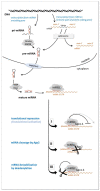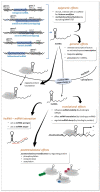Circulating Noncoding RNAs in Pituitary Neuroendocrine Tumors-Two Sides of the Same Coin
- PMID: 35563510
- PMCID: PMC9101693
- DOI: 10.3390/ijms23095122
Circulating Noncoding RNAs in Pituitary Neuroendocrine Tumors-Two Sides of the Same Coin
Abstract
Pituitary neuroendocrine tumors (PitNET) are common intracranial neoplasms. While in case of hormone secreting tumors pituitary hormone measurements can be used for monitoring the disease, in non-functional tumors there is a need to discover non-invasive biomarkers. Non-coding RNAs (ncRNAs) are popular biomarker candidates due to their stability and tissue specificity. Among ncRNAs, miRNAs, lncRNAs and circRNAs have been investigated the most in pituitary tumor tissues and in circulation. However, it is still not known whether ncRNAs are originated from the pituitary, or whether they are casually involved in the pathophysiology. Additionally, there is strong diversity among different studies reporting ncRNAs in PitNET. Therefore, to provide an overview of the discrepancies between published studies and to uncover the reasons why despite encouraging experimental data application of ncRNAs in clinical routine has not yet taken hold, in this review available data are summarized on circulating ncRNAs in PitNET. The data on circulating miRNAs, lncRNAs and circRNAs are organized according to different PitNET subtypes. Biological (physiological and pathophysiological) factors behind intra- and interindividual variability and technical aspects of detecting these markers, including preanalytical and analytical parameters, sample acquisition (venipuncture) and type, storage, nucleic acid extraction, quantification and normalization, which reveal the two sides of the same coin are discussed.
Keywords: biomarker; circRNA; circulating biomarker; liquid biopsy; lncRNA; miRNA; ncRNA; pituitary; pituitary adenoma.
Conflict of interest statement
The author declares no conflict of interest.
Figures





Similar articles
-
Circulating non-coding RNA biomarkers of endocrine tumours.Nat Rev Endocrinol. 2024 Oct;20(10):600-614. doi: 10.1038/s41574-024-01005-8. Epub 2024 Jun 17. Nat Rev Endocrinol. 2024. PMID: 38886617 Review.
-
Liquid Biopsy in Pituitary Neuroendocrine Tumors-Potential Biomarkers for Diagnosis, Prognosis, and Therapy.Int J Mol Sci. 2025 Apr 25;26(9):4058. doi: 10.3390/ijms26094058. Int J Mol Sci. 2025. PMID: 40362297 Free PMC article. Review.
-
Emerging Roles of miRNA, lncRNA, circRNA, and Their Cross-Talk in Pituitary Adenoma.Cells. 2022 Sep 19;11(18):2920. doi: 10.3390/cells11182920. Cells. 2022. PMID: 36139495 Free PMC article. Review.
-
Non-coding RNAs and exosomal non-coding RNAs in pituitary adenoma.Pathol Res Pract. 2023 Aug;248:154649. doi: 10.1016/j.prp.2023.154649. Epub 2023 Jun 28. Pathol Res Pract. 2023. PMID: 37453360 Review.
-
NcRNAs: A synergistically antiapoptosis therapeutic tool in Alzheimer's disease.CNS Neurosci Ther. 2024 Apr;30(4):e14476. doi: 10.1111/cns.14476. Epub 2023 Sep 22. CNS Neurosci Ther. 2024. PMID: 37735992 Free PMC article. Review.
Cited by
-
RETRACTED: The Emerging Role of Epigenetics in Metabolism and Endocrinology.Biology (Basel). 2023 Feb 6;12(2):256. doi: 10.3390/biology12020256. Biology (Basel). 2023. Retraction in: Biology (Basel). 2025 Jun 16;14(6):705. doi: 10.3390/biology14060705. PMID: 36829533 Free PMC article. Retracted. Review.
-
Special Issue "miRNAs in the Era of Personalized Medicine: From Biomarkers to Therapeutics 2.0".Int J Mol Sci. 2023 Jan 19;24(3):1951. doi: 10.3390/ijms24031951. Int J Mol Sci. 2023. PMID: 36768275 Free PMC article.
-
Circulating non-coding RNA biomarkers of endocrine tumours.Nat Rev Endocrinol. 2024 Oct;20(10):600-614. doi: 10.1038/s41574-024-01005-8. Epub 2024 Jun 17. Nat Rev Endocrinol. 2024. PMID: 38886617 Review.
-
Liquid Biopsy in Pituitary Neuroendocrine Tumors-Potential Biomarkers for Diagnosis, Prognosis, and Therapy.Int J Mol Sci. 2025 Apr 25;26(9):4058. doi: 10.3390/ijms26094058. Int J Mol Sci. 2025. PMID: 40362297 Free PMC article. Review.
-
[Plasma miRNA expression in patients with genetically confirmed multiple endocrine neoplasia type 1 syndrome and its phenocopies].Probl Endokrinol (Mosk). 2024 Jan 24;69(6):70-85. doi: 10.14341/probl13357. Probl Endokrinol (Mosk). 2024. PMID: 38311997 Free PMC article. Russian.
References
-
- Raverot G., Burman P., McCormack A., Heaney A., Petersenn S., Popovic V., Trouillas J., Dekkers O.M. European Society of Endocrinology European Society of Endocrinology Clinical Practice Guidelines for the Management of Aggressive Pituitary Tumours and Carcinomas. Eur. J. Endocrinol. 2018;178:G1–G24. doi: 10.1530/EJE-17-0796. - DOI - PubMed
Publication types
MeSH terms
Substances
Grants and funding
LinkOut - more resources
Full Text Sources
Medical

